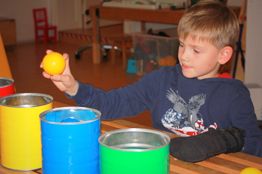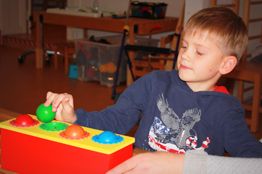
Constrained Induced Movement Therapie (CIMT)
The Constraint Induced Movement Therapy (CIMT) is one of the few evidence-based therapeutic approaches. It was first developed for adult stroke patients. For many years, it has been used successfully in working with children with unilateral spasmodic cerebral palsy or acquired hemiparesis. Its therapeutic successes has been proven by many studies.
By limiting the motion of the non-affected arm with a glove, splint, or sling the affected arm’s activity is triggered to counteract the self-taught disuse of the affected side. In addition, the affected arm / hand is stimulated by a functional repetitive training with increasing difficulty levels (shaping).
Currently, researchers are discussing the use of CIMT for very young children under 2 years of age with a study being conducted in Stockholm. Experience has shown that the disuse of the affected side can be counteracted more effectively the younger the children engaging with this therapy are.
Bimanual intensive training:
This approach focuses on the coordination of both hands. The focus is not that much on the affected hand’s capacity but on the effective motion execution. As in the CIMT approach, the functional repetitive training is applied in play. It is more difficult to offer bimanual exercises that rely on the use of the affected hand and simultaneously prevent the compensatory use of the non-affected side. The intensive bimanual training is more suitable for children who have already acquired hand motor skills and aims at improving the bimanual coordination. On the other hand, CIMT can be used to stimulate the spontaneous use of the affected hand and to improve the unimanual skills.
Make an appointment Evidence-based therapy



